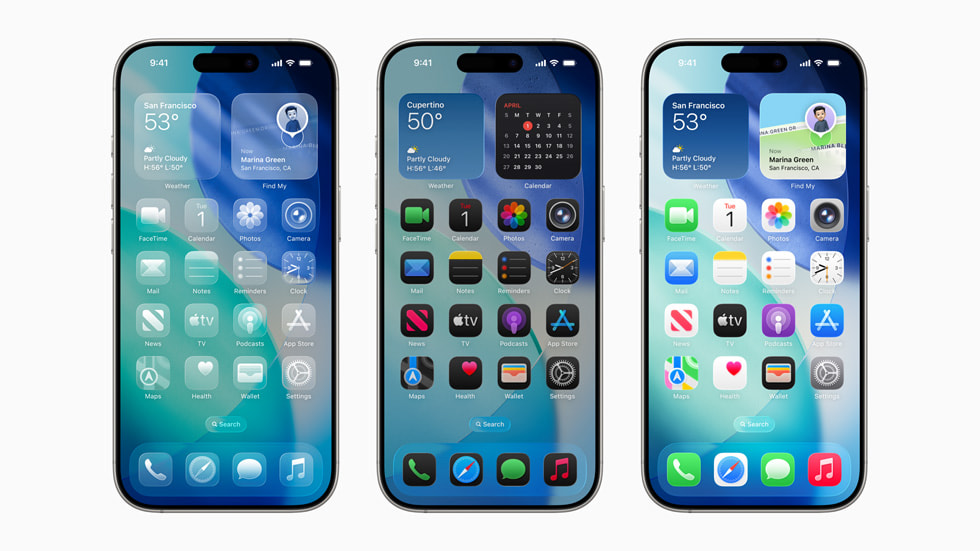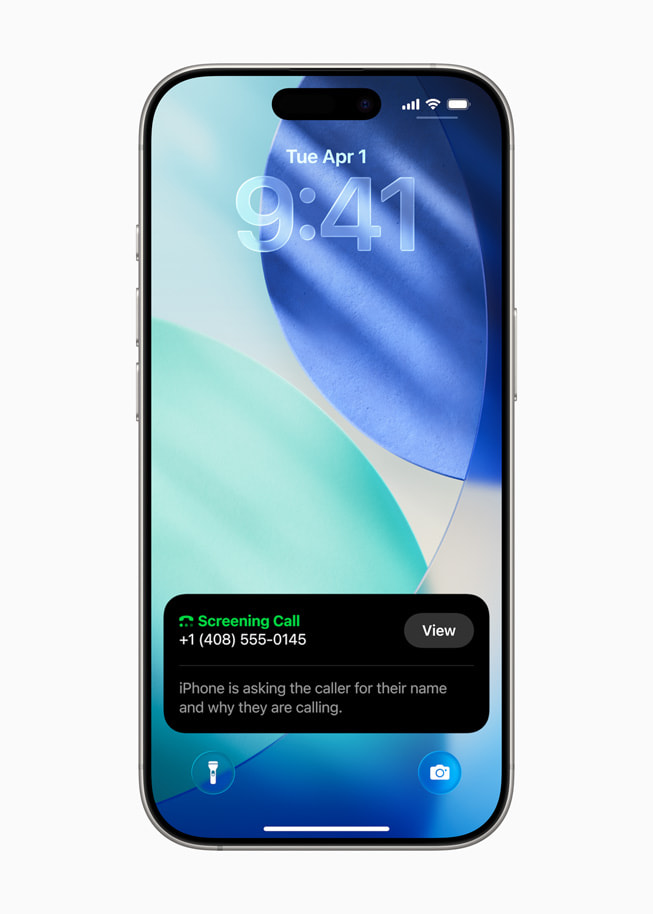Apple iOS 26 Update: All the New Features and Changes
Apple unveiled iOS 26 at WWDC 2025 (June 9), calling it a major update that “brings a beautiful new design, intelligent experiences, and improvements to the apps users rely on every day”. The update introduces a sweeping design overhaul, deep on-device Apple Intelligence (AI) features, and refinements across system apps. iOS 26 will launch free in fall 2025 (around September, alongside new iPhones) as a developer beta now and a public beta by July. It supports iPhone 11 and later (dropping 2017-era devices), with the latest AI-powered features requiring newer hardware (A17 Pro chips or M1+ Macs). The rest of this article breaks down the key changes in design, apps, performance, privacy, compatibility, and release timing.

Image Source: Apple
Design Overhaul and UI Changes

The most obvious change in iOS 26 is a new “Liquid Glass” look for the entire interface. Translucent, frosted glass effects and pastel colors give menus, buttons, and widgets a floating, ethereal feel. For example, Apple’s press release highlights “Liquid Glass”, a new translucent material that reflects and refracts surroundings, drawing more focus to content. Across iOS, controls and dialog boxes now use softer rounded corners and more “floating” layouts. Insider reports confirm navigation bars and dialogs will be semi-opaque and more rounded (akin to visionOS). In many apps (Music, Podcasts, News, etc.) the tab bar now floats above content and even shrinks to let content fill the screen.
The Lock Screen and Home Screen are also revamped. The Lock Screen’s clock will fluidly adjust its size and position to fit the wallpaper, and wallpapers gain subtle 3D parallax “spatial” motion effects when you tilt the phone. Widgets and app icons can now use a clear or frosted look (even showing background textures) for a more personal style. In the Photos app, images may display full-screen with only a slimmed-down bottom control bar. Overall, this is the biggest visual refresh since iOS 7: Bloomberg’s Mark Gurman calls it a “fundamentally change” and the largest UI update in years. For developers, new APIs let apps adopt these Liquid Glass materials so third-party apps can match the dynamic new style.
- Rounded, translucent interface: System-wide elements (toolbars, notifications, pop-ups) use soft corners and frosted backgrounds.
- 3D Lock Screen and Home effects: The clock adapts to the wallpaper, and wallpapers come alive with depth (Spatial Scenes) when the phone moves.
- Streamlined app layouts: Many apps have redesigned layouts with pill-shaped tab bars and full-screen content. For example, Safari pages now scroll continuously from top to bottom (hiding the URL bar), and Apple Music/News tab bars float and shrink during browsing. Photos gains separate Library and Collections tabs, and dialogs (like Control Center and permission prompts) use larger rounded toggles.
- Icon refresh: Leaks suggest Apple will make app icons more circular (somewhere between the current “squircle” and a true circle).
These design changes are illustrated in Apple’s iOS 26 previews and mockups.
Updated Built-in Apps and Productivity Tools
Along with the new design, many core apps receive feature upgrades:
- Safari: The browser adopts the new frosted look. Web pages now flow to the very top of the screen with a transparent “glass” address bar that disappears on scroll. Frequently-used controls (refresh, search) float at the top edge for quick access.
- Camera: The Camera app’s interface is simplified. Apple will use translucent pop‑out menus so you can tweak settings (filters, flash, etc.) without leaving the viewfinder. This cleaner layout keeps you focused on framing the shot.
- Phone: The Phone app now has a unified view: Favorites, Recents and Voicemail all appear in one scrollable screen (with an option to revert to the old tabbed design). New AI-powered call features help eliminate interruptions: Call Screening asks unknown callers for name/reason and displays it for you, and Hold Assist will notify you when a live agent is available if you’re stuck on hold. This gives users more context before answering or rejecting calls.

- Messages: The Messages app adds richer conversation features. iOS 26 can screen texts from unknown senders into a separate folder until you accept them. Group chats can now include polls, which the system will even suggest automatically based on context. You can set custom backgrounds for each conversation (including AI-generated scenic images via Image Playground). A new combination feature called “Genmoji” lets you fuse two emoji into one custom emoji. Messages also adds live typing indicators in group chats and lets you request, send, or receive Apple Cash payments directly in iMessage threads.
- Mail and Productivity: While Apple didn’t tout major Mail changes, iOS 26 includes a new Preview app (copied from macOS) for viewing and annotating PDFs and images. This makes it easier to mark up documents outside of Mail’s limited Markup. The Notes app gains Markdown export for better interoperability.
- Apple Music, Maps, and Wallet: Apple Music adds Lyrics Translation (showing translated lyrics line by line) and Lyrics Pronunciation guides so you can sing along in any language. Maps introduces Visited Places, which detects locations you visit frequently (restaurants, parks, etc.) and lists them (this data is end-to-end encrypted so only you see it). Maps also uses on-device intelligence to recognize your daily routine (home/work) and proactively offers your preferred route with live traffic updates. Wallet adds new payment options (installments, rewards) for in-store Apple Pay purchases and overhauled boarding passes that can share Live Activity flight updates and quick access to relevant info (airport maps, Find My, etc.).
- New Apple Games App: iOS 26 introduces an “Apple Games” app – a one-stop hub for gaming. It brings the App Store’s game section into one pre‑installed app (with Home, Arcade, Play Together, Library, Search tabs), offers editorial game recommendations, and houses leaderboards and achievements (replacing the old Game Center).
- Shortcuts: The Shortcuts app is redesigned to incorporate Apple Intelligence. You’ll see new Intelligent Actions powered by on-device AI (for example, writing tools, image creation, etc.) that make automation more accessible to casual users. Developers get a new Foundation Models framework that lets any app tap into Apple’s on-device generative models (fast, offline, and privacy-conscious)
.
Accessibility Improvements
Apple continues to enhance accessibility with iOS 26. New features (previewed in May 2025) include:
- App Store Accessibility Labels: Each app’s App Store page now displays “accessibility nutrition” badges for features like VoiceOver, captions, and reduced motion support.
- Accessibility Reader: A new system-wide reading mode can reformat text for easier reading (adjusting font, colors, spacing, etc.) and can be launched from any app or via the Magnifier app.
- Message Screening: iPhone can screen unknown SMS into a locked folder. (Users decide whether to allow a message sender into the main list, helping avoid spam.)
- Custom Backgrounds & Polls: (While not strictly an assistive feature, these messaging enhancements offer more ways to express ideas for all users.)
- Sound Recognition in CarPlay: CarPlay will alert drivers to important sounds—like a crying baby, doorbell or siren—even when the phone is not in hand.
- Braille Access: iPhone/iPad can become a Braille note-taking device. Users can type or connect a Braille device to enter text anywhere. Braille files (BRF) open natively, and a form of live captions is built in.
- Switch, Head, and Eye Control: Switch Control now offers faster keyboard typing (dwell-to-type) and expanded customization. Users can control the device with head movements, and a new “Eye Tracking” option lets someone select items by staring at them or using a switch.
- Brain‑Computer Interface (BCI) Support: iOS 26 adds a protocol so apps can accept input from approved BCI devices, letting users with paralysis navigate and control the iPhone without touch.
- Background Sounds and Haptics: Background ambient noises (rain, stream, white noise, etc.) get new audio EQ controls and can be timed via Shortcuts. Music Haptics (vibrations synced to rhythm) becomes customizable per track.
These updates (and more) were highlighted by Apple’s Accessibility Preview for iOS 26. In short, Apple is adding many new tools for vision, hearing, motor, and cognitive needs in this release.
Performance and Battery Optimizations
iOS 26 adds AI-powered battery management to improve efficiency on all compatible iPhones. According to reports, a new setting will analyze your usage habits and automatically limit power draw from apps or features when needed. For example, if you rarely use a certain background process, iOS 26 might scale it down to save energy. Apple even plans a lock-screen indicator showing charging time remaining (how long until 100%) when plugged in. These optimizations were designed with upcoming low‑battery‑capacity models in mind but will apply to any iPhone running iOS 26.
Apart from battery-specific features, Apple generally tunes iOS to run efficiently on older hardware as well. (Past releases often include under-the-hood performance tweaks, though Apple’s release notes focus on features.) The new on-device AI engine and optimized system frameworks should help keep animations smooth and app launch times fast on supported devices. In sum, Apple’s goal is to make your iPhone last longer per charge and feel snappier under load, but exact performance gains on older models will become clear after testing the final release.
Privacy and Security Enhancements
Privacy remains a core theme. All of Apple’s new AI features run on device without sending your data to external servers. For instance, the built-in translation in Messages, FaceTime and Phone uses Apple’s own language models stored locally, so your private conversations never leave the iPhone. Similarly, the new Foundation Model framework gives apps access to Apple’s powerful language AI on‑device. Apple explicitly says these features are “built with privacy at their core”.
iOS 26 also strengthens data protections. The new Visited Places in Maps (restaurants, parks, etc.) are stored end-to-end encrypted so even Apple can’t read them. Messages from unknown senders stay silenced and offline until you choose to accept them. Intelligent features that analyze emails (like auto-extracting order tracking info) only run locally on the iPhone. In short, Apple continues to process as much data as possible on-device and minimizes new tracking surfaces. Any new permissions (for location, microphone, etc.) will follow iOS’s strict opt-in model, though Apple hasn’t announced major permission changes. Overall, iOS 26’s security model is similar to iOS 25, just with more on-device AI and E2E encryption for added protection.
Compatibility and Device Support
Apple confirmed iOS 26 will support all iPhones from the 2019 iPhone 11 onward. In practice, this means iPhone 11, 12, 13, 14, 15, and 16 series are supported; older models (iPhone X, 8/8 Plus, and earlier) are dropped. iPads and Macs are getting parallel updates (iPadOS 26, macOS 26), but the focus here is on iPhone. Importantly, the most advanced Apple Intelligence features (live translation, personal Siri) require the latest hardware: iPhone 15/16 Pro models, Apple Silicon iPads/Macs, etc.. Lesser devices will still get the new design and app improvements, but some AI tasks won’t run or will require a paired newer device. In summary, if you own an iPhone 11 or newer, you’ll be able to update to iOS 26 and use its core features; just know that the bleeding-edge AI tools are limited to the newest chips.
Release Schedule
According to Apple, iOS 26 is now available as a developer beta as of WWDC 2025 (June 9). A public beta will roll out in July 2025, allowing anyone to try the new features ahead of time. The final public release is expected in September 2025, likely timed with the launch of Apple’s next iPhone lineup. Apple’s press release confirms iOS 26 will arrive as a free software update in fall 2025 for supported iPhones. In short, the timeline mirrors past years: preview at WWDC, summer betas, then a formal release in September. Users on the iPhone Beta Software Program should look for the developer beta now, public beta next month, and final build around mid-late September.
By the time of writing, iOS 26 is in testing. We expect Apple to refine these features through the beta period. In September, when iOS 26 is released to everyone, iPhone users on iPhone 11 or newer will see this redesigned interface and the new capabilities described above. Sources: Authoritative details come from Apple’s iOS 26 preview press release and in-depth technology reports (MacRumors). All claims are cited from those sources. The images above are official Apple screenshots illustrating iOS 26’s new design and features. Each feature and improvement mentioned is documented in those sources.
You may also like

Summary
Read Full
open_in_newSamsung is accelerating its festive-season outreach in India’s Tier-2 and Tier-3 markets, combining AI-driven products—from smartphones to home appliances—with enhanced affordability via Samsung Finance+, expanded store networks, and powerful promotions, positioning smart tech as accessible to more consumers across smaller cities.

Ocado Targets Cash Flow Positivity by 2026 Amid Strategic Shift in Warehouse Automation
Summary
Read Full
open_in_newOcado, the UK-based online grocer and tech innovator, aims to achieve positive cash flow by 2025/26 and full-year profitability by 2026/27. The company is doubling down on its AI-powered warehouse automation systems to drive sustainable growth and long-term financial stability.

Solid-State Battery Breakthrough: UC Riverside Researchers Promise 3-Minute Charging and Longer Life
Summary
Read Full
open_in_newA research team at UC Riverside has unveiled a solid-state battery prototype that charges in just 3 minutes and lasts significantly longer than traditional lithium-ion batteries. This technological leap could revolutionize electric vehicles (EVs) and consumer electronics, addressing two of the most critical pain points—charging time and battery longevity.

Germany Bets Big on Quantum: $5 Billion Push to Industrialize Quantum Computing
Summary
Read Full
open_in_newGermany has declared its intention to become a global leader in quantum computing, committing over $5 billion in public funding and launching the Quantum Technology and Application Consortium (QUTAC). The move marks a pivotal effort to industrialize quantum technologies across key sectors like logistics, finance, and pharmaceuticals.

China’s Private Space Sector Soars: Space Epoch Launches VTVL Rocket as SJ Satellites Achieve In-Orbit Refueling Milestone
Summary
Read Full
open_in_newChina’s private space industry achieved two major milestones: Space Epoch launched its reusable Yuanxingzhe‑1 VTVL rocket, and SJ-series satellites reportedly performed the world’s first in-orbit satellite refueling. These breakthroughs signal China’s rapid progress in reusable launch tech and orbital servicing, challenging global leaders like SpaceX in space innovation.

Samsung Electronics Warns of 56% Profit Drop as U.S. AI Chip Export Curbs Hit China Sales
Summary
Read Full
open_in_newSamsung Electronics has issued a stark warning: its Q2 2025 operating profit is expected to plunge by 56% year-on-year, as U.S. export restrictions on AI chips to China ripple through the global tech landscape. This sharp decline underscores the growing vulnerability of the semiconductor sector to geopolitical tensions.

Google Fiber & Nokia Trial Network Slicing for Smarter Home Broadband
Summary
Read Full
open_in_newGoogle Fiber and Nokia have partnered to test network slicing for home broadband, an innovation that allows households to allocate separate high-priority bandwidth lanes for different use cases—like online gaming, video streaming, and secure banking. The move signals a significant leap toward customized, AI-optimized consumer internet.


























































































































































































































































































































































